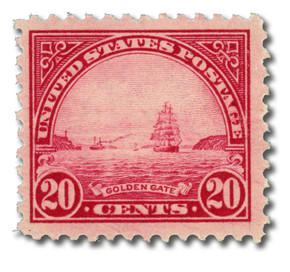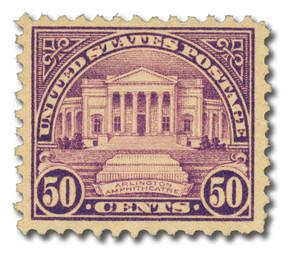
U.S. #555
Series of 1922-25 3¢ Lincoln
Flat Plate Printing
Issue Date: February 12, 1923
First City: Hodgenville, KY and Washington, DC
Quantity Issued: 372,593,077
Printed by: Bureau of Engraving and Printing
Printing Method: Flat plate
Perforation: 11 gauge
Color: Violet
Lincoln’s image on U.S. 555 was based on a photograph... more
U.S. #555
Series of 1922-25 3¢ Lincoln
Flat Plate Printing
Issue Date: February 12, 1923
First City: Hodgenville, KY and Washington, DC
Quantity Issued: 372,593,077
Printed by: Bureau of Engraving and Printing
Printing Method: Flat plate
Perforation: 11 gauge
Color: Violet
Lincoln’s image on U.S. 555 was based on a photograph by Mathew Brady, one of the leading photographers of the time. The photo was taken just a few days before Lincoln’s 55th birthday, and became the official portrait of the Bureau of Engraving and Printing for Lincoln. The stamp was issued in both Washington, D.C., and Hodgenville, Kentucky – just three miles from Lincoln’s birthplace at Rock Spring Farm.
The Series of 1922-25 and the Wheels of Progress
In 1847, when the printing presses first began to move, they didn’t roll – they “stamped” in a process known as flat plate printing. The Regular Series of 1922 was the last to be printed by flat plate press, after which stamps were produced by rotary press printing.
By 1926, all denominations up to 10¢ – except the new ½¢ – were printed by rotary press. For a while, $1 to $5 issues were done on flat plate press due to smaller demand.
In 1922, the Post Office Department announced its decision to issue a new series of stamps to replace the Washington-Franklin series, which had been in use since 1908. Many criticized the change, believing it was being made to satisfy collectors rather than to fill an actual need. However, the similar designs and colors of the current stamps caused confusion, resulting in a substantial loss in revenue each year. In busy situations, postal clerks could not tell at a glance if the correct postage was being used.
Postal employees requested a variety of designs which could easily be distinguished from one another. Great care was taken to make sure the new designs could not be confused. Although the frames are similar, the vignettes (central designs) are distinctive. Prominent Americans, as well as scenes of national interest, were chosen as subjects for the new series.
In addition to issuing new designs, the Department developed a plan to first distribute a small number of each stamp on a particular date in a selected town which was of historical and geographical significance to the subject. The plan greatly increased interest and began a new trend of collecting stamps on covers or envelopes postmarked on the first day of issue.
Lincoln Memorial Issue
On February 12, 1909, the US Post Office issued a set of stamps commemorating the 100th anniversary of Abraham Lincoln’s birth.
One year after Lincoln’s assassination, the Post Office issued its first stamp honoring the fallen president. That black 1866 issue is considered to be America’s first mourning stamp. From then until 1907, there was always at least one definitive stamp picturing Lincoln.
Then in 1908, the Post Office introduced the Washington-Franklin Series, a long-running series that would only feature the portraits of George Washington and Benjamin Franklin. There was some public outcry in reaction to this, as some felt that Lincoln should always be honored on US stamps.
Luckily for them, they didn’t have to wait long to get a new stamp. On February 12, 1909, the Post Office issued the first three Lincoln Memorial Issue stamps on what would have been his 100th birthday. The stamps all featured the same design, based on a statue of Lincoln located in Chicago’s Grant Park. The stamps didn’t include Lincoln’s name but did include his birth date and birth year and the year of issue.
The stamps were notable for being the first definitive-sized commemoratives. And their two-cent denomination, the rate for a single-ounce, first-class letter, made them the first Lincoln stamps to see usage on regular mail in the US. Additionally, these were the first US commemoratives issued in just one denomination. Previous commemorative issues (such as the Columbians, Trans-Mississippi Exposition, and Pan-American Exposition) were produced in multiple denominations to meet a variety of postal services.
In all, the Lincoln Memorial Issue consisted of three stamps – a perf. 12 stamp, an imperforate stamp, and one printed on experimental bluish-gray paper (also perforated 12). The bluish-gray paper was created due to the BEPs desire to create a better product.
One of the main problems the Bureau was encountering was paper shrinkage. Since the stamps were wet printed they would shrink as the paper dried, causing irregular and “off center” perforations, which resulted in a considerable amount of waste. To combat the problem, the Bureau changed the composition of the paper by adding 35% wool rag to the wood pulp, which gave them a bluish tint.
Lincoln once again returned to definitive stamps on February 12, 1923, after the Post Office ended the Washington-Franklin Series. And he reappeared on commemoratives again in 1959, on a set of stamps issued to mark the 150th anniversary of his birth. The first of those stamps, US #1113, was issued on his birthday, February 12.
And 50 years later Lincoln was honored with another set of stamps honoring his 200th birthday in 2009. It’s interesting to note that over the years, several Lincoln definitives were also issued on November 19, the date of Lincoln’s Gettysburg Address.
Less
Most Orders Ship
within 1 Business Day
90 Day Return Policy
Satisfaction Guaranteed
Earn Reward Points
for FREE Stamps & More













